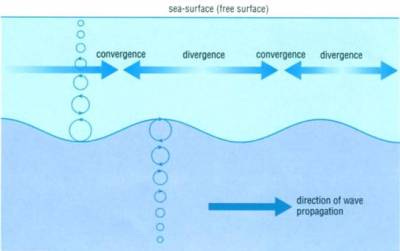What causes these lines of smooth water?
Looking out from a cliff over the ocean, you've probably noticed those peculiar patches of glassy water breaking up the surface chop. On days with just a whisper of breeze, these smooth areas often form distinct lines where floating debris collects – everything from natural foam to the occasional tourist’s smartphone in a waterproof case.
Sometimes, these lines are just indications of kelp, which we know attenuate surface waves. But the lines in the picture below, taken from Scripps, are caused by high-frequency internal waves.

Water in the ocean stacks like a layered liquid, with colder, saltier water sinking below warmer, fresher layers due to density differences. This stratification creates the necessary conditions for waves to form not just where we see them (at the air-water boundary) but also deep within the water column itself. These internal waves are massive – the ones in La Jolla typically reach heights of 6 meters or more in 14 meters of water – yet they move with a strange slowness, taking hours to complete a single oscillation compared to the seconds required for surface waves.
Now, even though the amplitude of these particular waves are meters tall, and ones hundreds of meters tall have been measured in the South China Sea, the change in surface amplitude is tiny - we're talking less than a couple of centimeters. You are unlikely to ever notice the change in sea surface height from these waves.
You are, however, likely to see the patches of smooth water that they drive at the surface. This happens because of convergence and divergence at the surface. Behind the peak of an internal wave, water flows inward from both directions, creating convergence. This piles up water and forces it downward in a slight downwelling that suppresses small ripples, creating that slick, mirror-like surface. These slicks appear lighter because they reflect more light than the surrounding choppy water.
The opposite occurs in front of the wave peak, where water flows outward in both directions – a divergence zone. Here, water wells up from below, allowing more small-scale ripples to form and giving the surface a rougher texture. The alternating pattern creates those distinctive bands that slowly march towards the shore.

La Jolla serves as a near-perfect natural laboratory for studying these waves, thanks to its submarine canyon that drops off more than 500 meters just offshore. This dramatic change in bathymetry forces deep water to rise and fall as internal tides move in and out, generating these subsurface waves.
Beyond making for compelling PhD research (if I do say so myself), these internal waves play critical ecological roles. They help mix nutrient-rich deep water into the sunlit zone where phytoplankton thrive, and periodically deliver cooler water to refresh local kelp forests struggling against warming ocean temperatures.
Tracking and quantifying the ecological impact of these internal waves requires specialized equipment - thermistor chains, acoustic Doppler current profilers, and computational models. Yet their surface expressions are visible to anyone paying attention. These lines are a great opportunity for us oceanographers to look up from our code to see our science happening in real time, and now you can too.
Further Reading:

